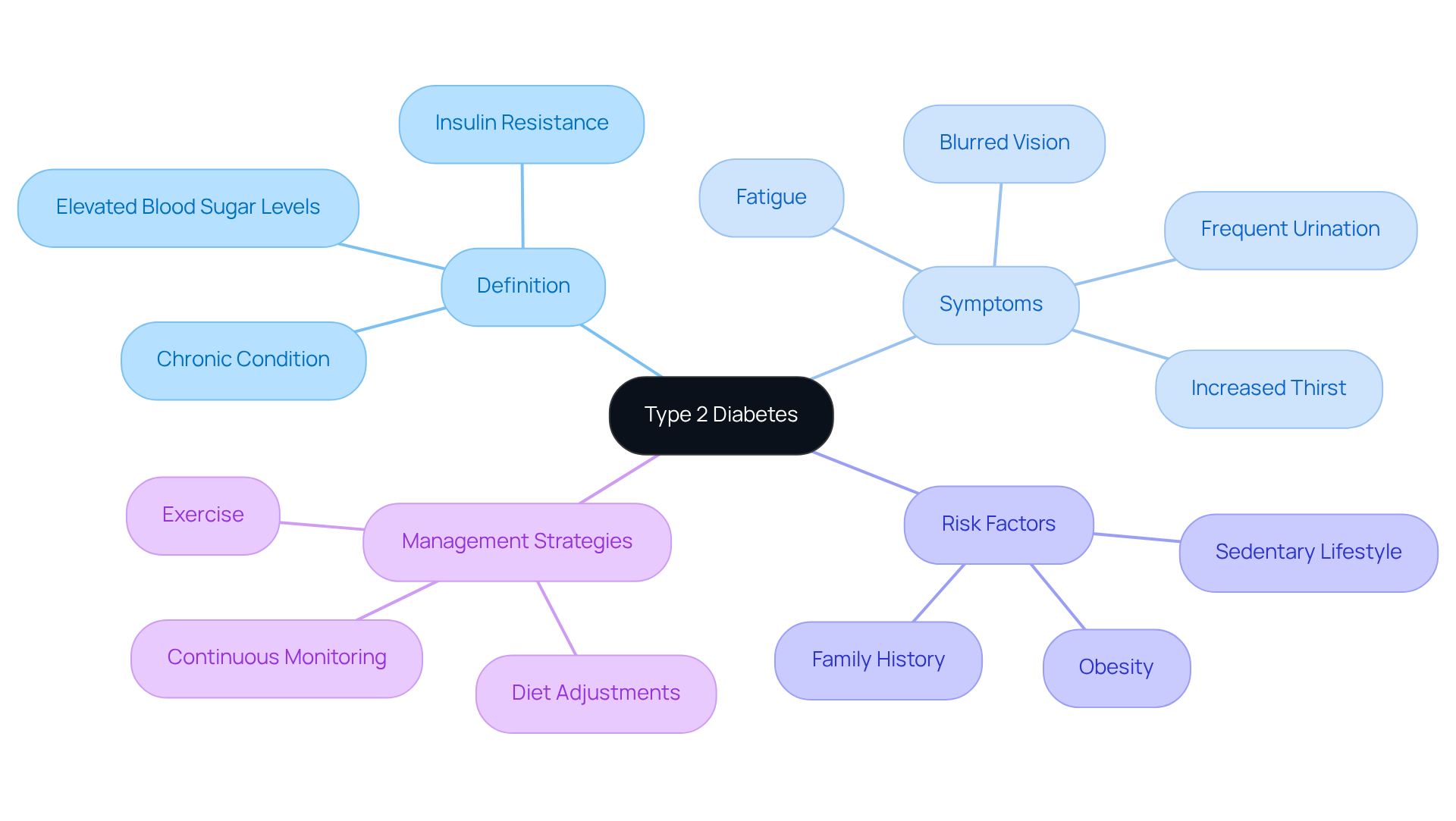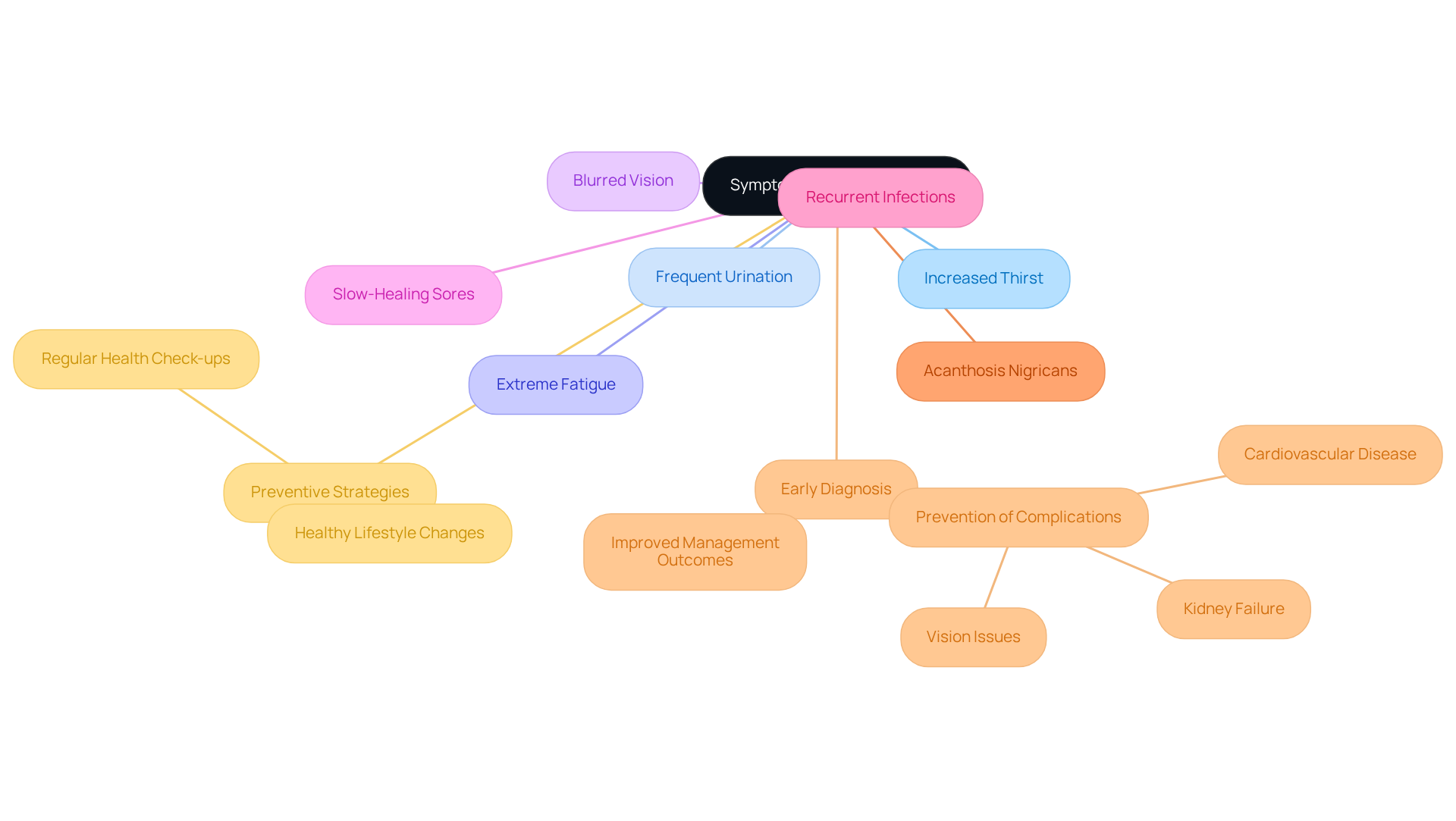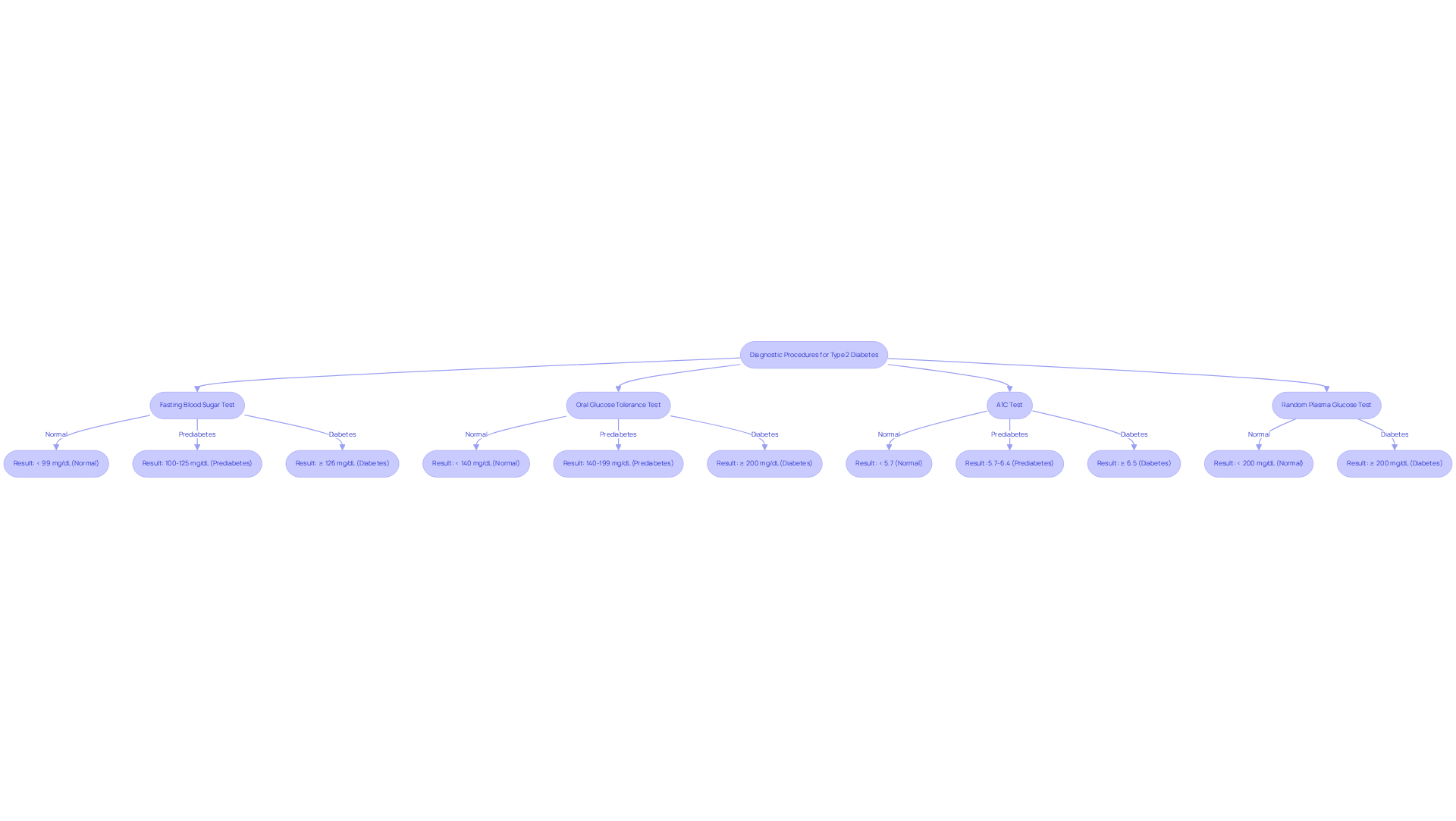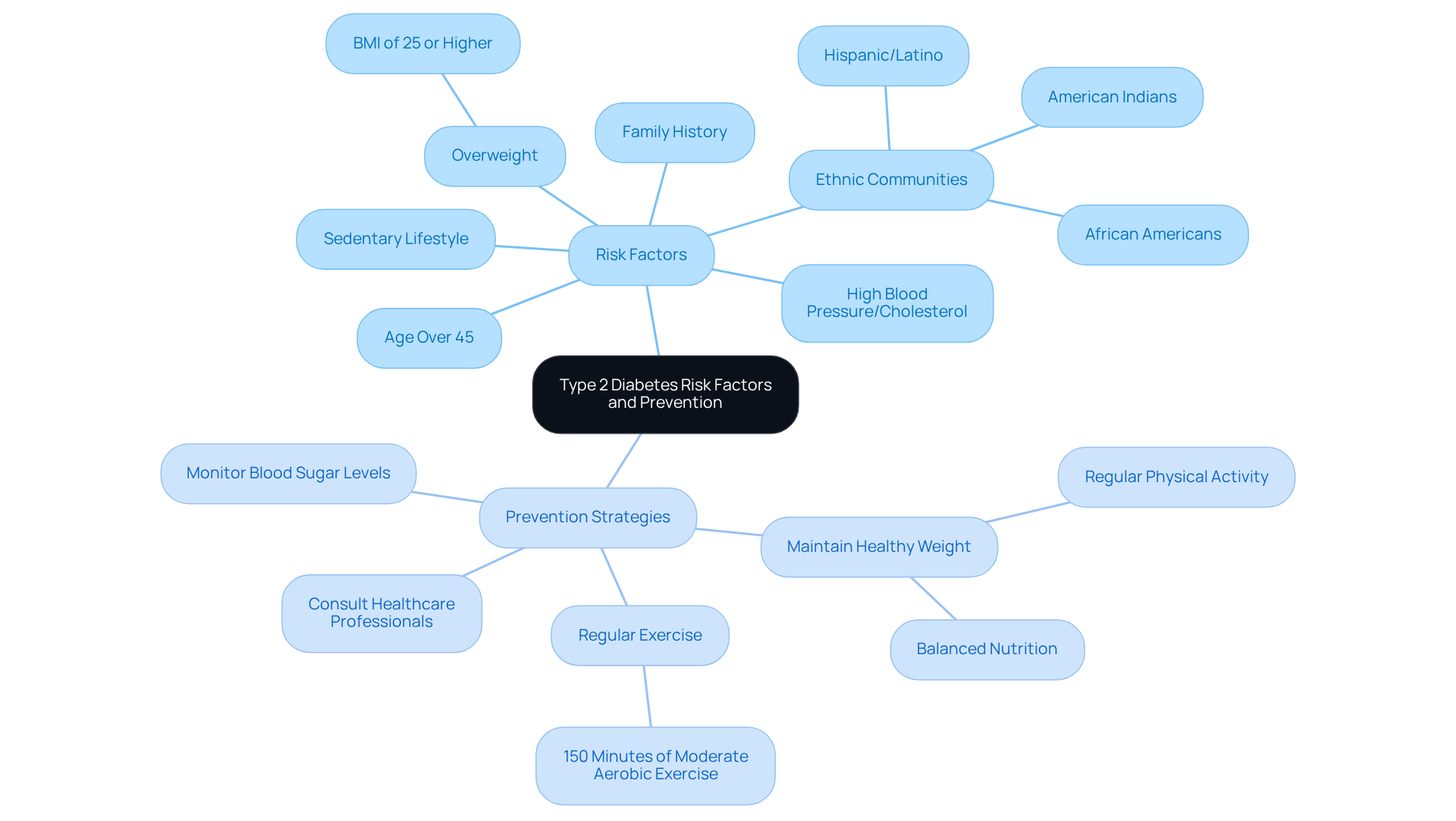Overview
Recognizing the signs of Type 2 diabetes can be overwhelming, but understanding symptoms like increased thirst and fatigue is the first step toward taking control. It’s important to know that specific tests, such as the fasting blood sugar test and the A1C test, can help measure your blood glucose levels accurately. Early detection through these diagnostic procedures is crucial, as it empowers you to manage your health effectively and prevent serious complications.
Remember, you’re not alone in this journey. Seeking support and resources can make a significant difference. These steps not only provide clarity but also open up avenues for better health management. If you have concerns or questions, reaching out to healthcare professionals can provide the guidance you need. Together, we can navigate this path toward wellness.
Introduction
Understanding the complexities of Type 2 Diabetes is essential, especially considering its prevalence among millions and the serious health risks associated with it. This article delves into the critical steps and insights needed for diagnosing this condition. Our aim is to offer you valuable information on:
- Recognizing symptoms
- Understanding diagnostic procedures
- Identifying risk factors
It's understandable to feel overwhelmed by the landscape of diabetes diagnosis and management. By exploring these key aspects, we hope to empower you to take control of your health and prevent potential complications. Remember, you're not alone in this journey.
Understand Type 2 Diabetes: Definition and Overview
Condition 2, known as Type 2 Diabetes, is a chronic ailment that can hinder your body's ability to process sugar (glucose), which is essential for energy. Unlike Type 1 diabetes, where the pancreas doesn't produce insulin, individuals with Type 2 diabetes either produce insufficient insulin or their cells resist its effects. This dysfunction can lead to elevated blood sugar levels, potentially resulting in serious health complications if not managed properly.
Recognizing the key characteristics of Type 2 Diabetes is essential for knowing how to diagnose diabetes type 2 and understanding its implications. Common symptoms include:
- Increased thirst
- Frequent urination
- Fatigue
- Blurred vision
It's important to note that this condition is often linked to factors such as obesity, a sedentary lifestyle, and family history. In the U.S., around 29.7 million people are diagnosed with diabetes, representing 8.9% of the population, with an additional 8.7 million who remain undiagnosed.
At T2DSolutions, we truly care about providing newly diagnosed patients with the resources and support they need to understand and manage their condition effectively. Current insights into management strategies emphasize the importance of lifestyle modifications. Simple changes, like adjusting your diet and engaging in regular physical activity, can make a significant difference. Studies show that losing just 5% to 7% of your body weight and participating in 150 to 300 minutes of moderate exercise each week can greatly decrease the likelihood of developing this condition. Moreover, the latest research highlights the value of continuous glucose monitoring and personalized treatment plans in effectively managing blood sugar levels.
For newly diagnosed patients, understanding how to diagnose diabetes type 2 is crucial, as early detection and intervention can prevent complications such as cardiovascular disease, kidney failure, and vision impairment. By taking a proactive approach to your management and utilizing the resources available at T2DSolutions, you can lead a healthier life and reduce the risks associated with this prevalent condition. Remember, you're not alone in this journey; we are here to support you every step of the way.

Identify Symptoms of Type 2 Diabetes
If you’re experiencing symptoms of Type 2 Diabetes, it’s important to understand how to diagnose diabetes type 2 and know what to look for. Common signs include:
- Increased thirst
- Frequent urination
- Extreme fatigue
- Blurred vision
- Slow-healing sores
- Recurrent infections
You might also notice areas of darkened skin, especially in the armpits and neck, a condition called acanthosis nigricans. Recognizing these symptoms is crucial for learning how to diagnose diabetes type 2; early intervention can significantly improve your management outcomes.
Research shows that understanding how to diagnose diabetes type 2 promptly can help prevent complications like cardiovascular disease, kidney failure, and vision issues. These are common among those with Type 2 Diabetes, and it’s significant to note that this condition is the leading cause of newly identified adult blindness in individuals aged 20 to 74 years. Alarmingly, around 252 million people are living with undiagnosed blood sugar issues. This highlights the importance of recognizing symptoms and understanding how to diagnose diabetes type 2.
If you observe any of these symptoms, please consult a healthcare professional to understand how to diagnose diabetes type 2 through a thorough evaluation. Early identification not only aids in swift diagnosis but also relates to understanding how to diagnose diabetes type 2 as part of preventive strategies. This can help you avoid or postpone complications. Remember, you’re not alone in this journey; we are here to support you every step of the way.
For more information and resources on managing diabetes, visit T2DSolutions. It’s your comprehensive hub for diabetes education and support. This proactive approach can enhance your quality of life and reduce the risk of severe health issues. You're taking an important step by seeking knowledge and support.

Follow Diagnostic Procedures for Type 2 Diabetes
Understanding how to diagnose diabetes type 2 can help make the process less overwhelming and empower you on your journey to better health. Here are some essential tests that healthcare providers typically use:
-
Fasting Blood Sugar Test: This test measures your blood sugar levels after an overnight fast. If your result is 126 mg/dL or higher, it may indicate a specific condition. Normal fasting blood sugar levels are considered to be 99 mg/dL or below, while levels between 100 and 125 mg/dL suggest prediabetes. This test is crucial as it provides a clear snapshot of how well your body manages glucose without the influence of recent food intake.
-
Oral Glucose Tolerance Test (OGTT): This test involves measuring your blood sugar levels before and two hours after consuming a sugary drink. A reading of 200 mg/dL or higher indicates the presence of the condition. The OGTT is particularly effective in assessing how your body processes sugar over time, making it a valuable tool for diagnosis.
-
A1C Test: This test reflects your average blood sugar levels over the past two to three months. An A1C of 6.5% or higher signifies elevated blood sugar levels. The A1C test is broadly advised because it offers a longer-term perspective on blood sugar regulation, which is crucial for managing your condition effectively.
-
Random Plasma Glucose Test: This test assesses your blood glucose at any time of the day. A level of 200 mg/dL or higher, especially if severe symptoms are present, can suggest the condition.
It's understandable to feel uncertain about how to diagnose diabetes type 2 with these tests, but discussing them with your healthcare provider is vital. They can help determine the most appropriate approach based on your individual health needs. Recent research highlights the importance of understanding how to diagnose diabetes type 2 accurately, as early detection can significantly impact treatment outcomes. For instance, studies show that approximately 1 in 3 adults has prediabetes, and those diagnosed can lower their risk of developing Type 2 Diabetes by 58% through lifestyle changes, including weight loss and regular exercise. Additionally, the serious implications of this condition are underscored by the statistic that about 73,000 lower-limb amputations were performed in individuals aged 20 and older with the illness.
Incorporating insights from endocrinologists, it becomes clear that understanding how to diagnose diabetes type 2 and the implications of these tests is crucial for effectively managing blood sugar disorders. T2DSolutions advocates a comprehensive strategy for managing the condition, including lifestyle modifications and community involvement, which can further assist you on your journey. Regular follow-up testing may be necessary to confirm initial results and ensure a comprehensive treatment plan is established. Remember, you’re not alone in this journey. For further details on blood sugar management education and support, consider checking the resources offered at T2DSolutions.

Recognize Risk Factors and Prevention Strategies
Recognizing Risk Factors and Prevention Strategies
Understanding the risk factors associated with Type 2 Diabetes is crucial for your health journey. Several factors can increase the likelihood of developing this condition, such as:
- Being overweight (with a BMI of 25 or higher)
- Leading a sedentary lifestyle
- Being over the age of 45
- Having a family history of diabetes
- Dealing with high blood pressure or abnormal cholesterol levels
Additionally, certain ethnic communities, including African Americans, American Indians, and Hispanic/Latino populations, are at a heightened risk. By identifying these factors, you can take proactive steps toward reducing your risk.
To support your health, consider adopting these strategies:
- Maintain a Healthy Weight: Achieving and sustaining a healthy weight through balanced nutrition and regular physical activity is vital. Research indicates that weight loss combined with increased physical activity can reduce the risk of developing Type 2 Diabetes by as much as 58%.
- Engage in Regular Exercise: Aim for at least 150 minutes of moderate aerobic exercise each week. Activities like brisk walking, cycling, or swimming not only assist in weight management but also enhance your overall well-being.
- Monitor Blood Sugar Levels: If you find yourself at risk, regularly tracking your blood sugar levels can provide insight on how to diagnose diabetes type 2 by identifying any abnormalities early, allowing for timely intervention.
- Consult Healthcare Professionals: Seeking personalized advice from healthcare providers can empower you to make informed decisions about your health and necessary lifestyle changes.
Moreover, T2DSolutions serves as a valuable resource hub for diabetes education and community support, offering tools and information to help you manage your health effectively. Remember, you are not alone in this journey. By recognizing these risk factors and implementing preventive strategies, you can significantly lower your chances of developing Type 2 Diabetes. It’s important to acknowledge that this condition affects over 38 million Americans, highlighting the urgency for lifestyle changes in prevention and management. We are here to support you every step of the way.

Conclusion
Understanding how to diagnose Type 2 Diabetes is essential for effective management and the prevention of serious health complications. By recognizing the symptoms, undergoing the proper diagnostic tests, and being aware of the associated risk factors, you can take proactive steps toward your health. This comprehensive approach not only aids in early detection but also emphasizes the importance of lifestyle modifications that can significantly improve your outcomes.
It's important to be vigilant about symptoms such as:
- Increased thirst
- Frequent urination
- Fatigue
Additionally, the diagnostic procedures, including fasting blood sugar tests and A1C tests, are critical in confirming the presence of the condition. Coupled with an understanding of risk factors and prevention strategies, you can empower yourself to make informed health decisions.
Ultimately, the message is clear: early diagnosis and proactive management of Type 2 Diabetes can lead to a healthier life and reduce the risks associated with this prevalent condition. By utilizing resources like T2DSolutions and committing to lifestyle changes, you can navigate your health journey with confidence and support. Taking these steps not only benefits your personal health but also contributes to a broader awareness of diabetes management within the community. Remember, you're not alone in this journey, and we are here to support you every step of the way.
Frequently Asked Questions
What is Type 2 Diabetes?
Type 2 Diabetes is a chronic condition that affects the body's ability to process sugar (glucose), which is essential for energy. It occurs when the body produces insufficient insulin or when cells resist insulin's effects, leading to elevated blood sugar levels.
How does Type 2 Diabetes differ from Type 1 Diabetes?
Unlike Type 1 Diabetes, where the pancreas does not produce insulin at all, individuals with Type 2 Diabetes either produce insufficient insulin or their cells do not respond effectively to insulin.
What are the common symptoms of Type 2 Diabetes?
Common symptoms include increased thirst, frequent urination, fatigue, and blurred vision.
What factors are linked to the development of Type 2 Diabetes?
Type 2 Diabetes is often linked to factors such as obesity, a sedentary lifestyle, and family history.
How prevalent is Type 2 Diabetes in the U.S.?
Approximately 29.7 million people in the U.S. are diagnosed with diabetes, which represents 8.9% of the population. An additional 8.7 million people remain undiagnosed.
What management strategies are recommended for Type 2 Diabetes?
Management strategies emphasize lifestyle modifications, including dietary changes and regular physical activity. Losing 5% to 7% of body weight and engaging in 150 to 300 minutes of moderate exercise each week can significantly reduce the likelihood of developing the condition.
How important is early detection of Type 2 Diabetes?
Early detection and intervention are crucial as they can prevent complications such as cardiovascular disease, kidney failure, and vision impairment.
What resources are available for newly diagnosed patients?
T2DSolutions provides resources and support for newly diagnosed patients to help them understand and manage their condition effectively. Continuous glucose monitoring and personalized treatment plans are also emphasized for managing blood sugar levels.
What should newly diagnosed patients keep in mind about their journey with Type 2 Diabetes?
Newly diagnosed patients should take a proactive approach to management, utilize available resources, and remember that they are not alone in their journey; support is available every step of the way.



